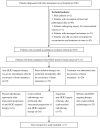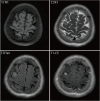Brain Radiotherapy Combined with Targeted Therapy for HER2-Positive Breast Cancer Patients with Brain Metastases
- PMID: 39071808
- PMCID: PMC11278000
- DOI: 10.2147/BCTT.S460856
Brain Radiotherapy Combined with Targeted Therapy for HER2-Positive Breast Cancer Patients with Brain Metastases
Abstract
Background: Research on the sequencing of brain radiotherapy and targeted chemotherapy after brain metastasis (BM) in HER2-positive breast cancer patients is limited and inconclusive. This study investigated the efficacy of sequential delivery of radiotherapy and targeted therapy in patients with human epidermal growth factor receptor 2 (HER2)-positive breast cancer with BM.
Methods: Fifty-seven patients were categorized into two groups: the targeted-radiotherapy group (receiving 2-8 cycles of anti-HER2-targeted therapy followed by radiotherapy after BM) and the radiotherapy-targeted group (undergoing radiotherapy first, followed by regular anti-HER2-targeted therapy). The study endpoints were intracranial progression-free survival (iPFS) and overall survival. Factors associated with intracranial progression and mortality were assessed by univariate and multivariate Cox proportional hazards analysis.
Results: Patients in the radiotherapy-targeted group had better iPFS (P < 0.001), while there was no significant difference in overall survival between the two groups (P = 0.145). Multivariate Cox analysis showed that different sequential treatment groups were independent prognostic factors for iPFS. In patients with a modified breast graded prognostic assessment score of 3.5-4.0, the median survival time was 26 months in the radiotherapy-targeted group and 22 months in the targeted-radiotherapy group (P = 0.019).
Conclusion: Overall, radiotherapy followed by targeted therapy may improve survival in HER2-positive breast cancer patients with BM, particularly in those with a modified breast graded prognostic assessment score of 3.5-4.0.
Keywords: HER2; HER2-targeted drugs; brain metastasis; breast cancer; craniocerebral radiotherapy.
© 2024 Tang et al.
Conflict of interest statement
The authors declare no conflicts of interest for this work.
Figures






References
-
- Tabouret E, Chinot O, Metellus P, Tallet A, Viens P, Goncalves A. Recent trends in epidemiology of brain metastases: an overview. Anticancer Res. 2012;32(11):4655–4662. - PubMed
-
- Yardley DA, Kaufman PA, Huang W, et al. Quantitative measurement of HER2 expression in breast cancers: comparison with ‘real-world’ routine HER2 testing in a multicenter collaborative biomarker study and correlation with overall survival. Breast Cancer Res. 2015;17(1):41. doi:10.1186/s13058-015-0543-x - DOI - PMC - PubMed
LinkOut - more resources
Full Text Sources
Research Materials
Miscellaneous

